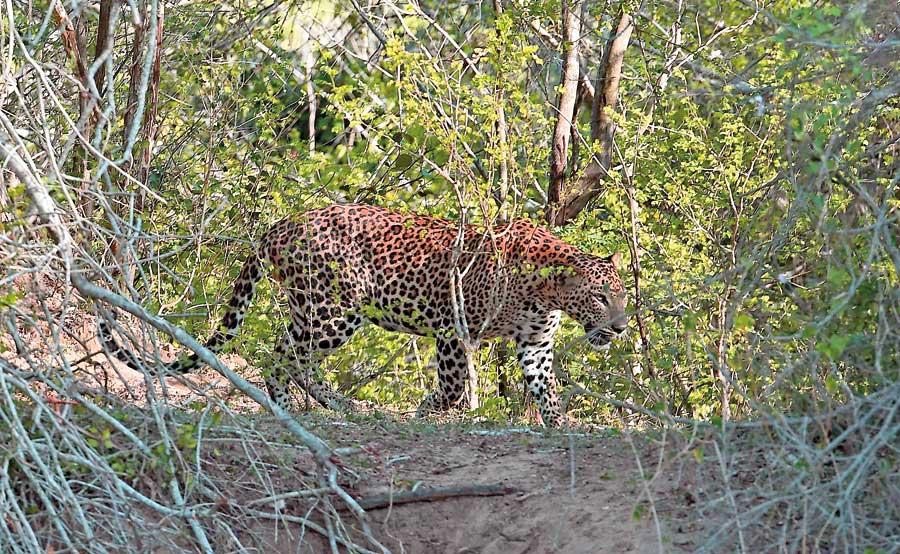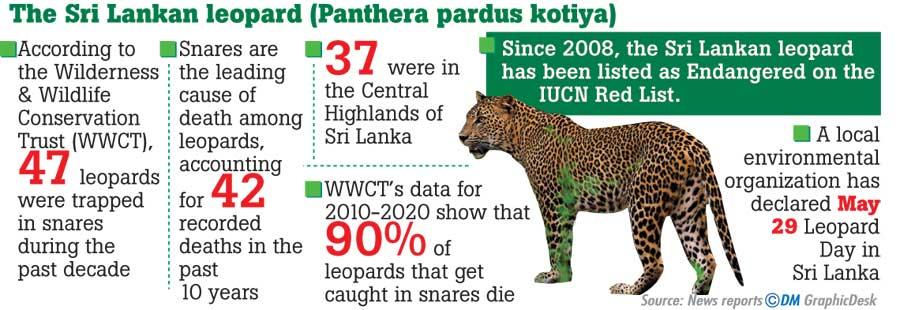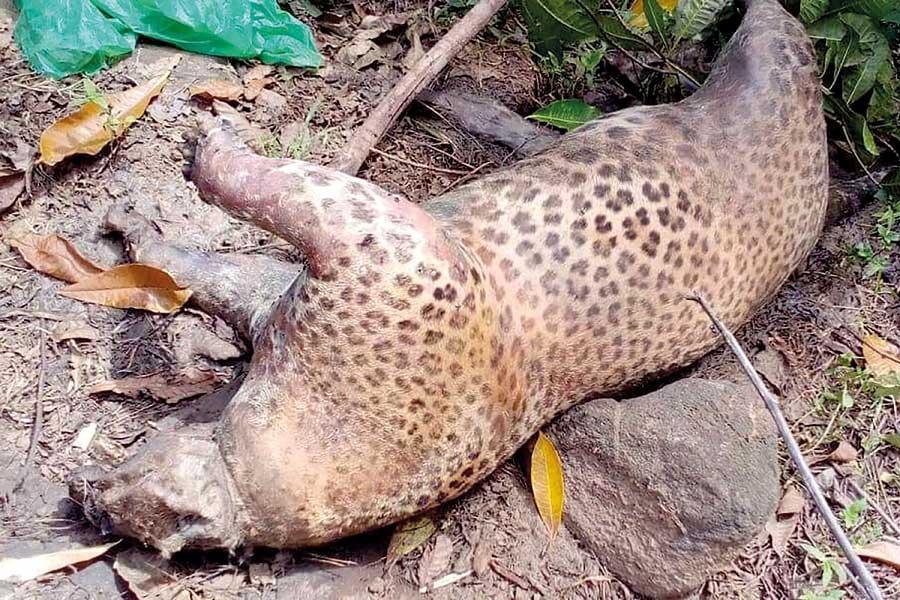12 Aug 2020 - {{hitsCtrl.values.hits}}

The animal is valuable to hunters for its teeth, nails etc (Pix AFP)
- If leopards are found in your region or estate or in the event a leopard cub is found do not touch it
- Severe punishments must be meted out to those caught with snares
Sri Lanka Leopard or Panthera Pardus Kotiya is the largest species of cat in Sri Lanka. It is unique to the island and categorized as ‘endangered’ by International Union of Conservation of Nature (IUCN). This leopard apparently is not Respected by the Department of Wild Life Conservation, the Department of Forests or trap laying villagers or the law enforcement authorities. The animal is valuable to hunters for its teeth, nails etc. The leopard was widespread across the island 20-30 years ago. Now restricted to patches  of forests in the mid and hill country the number of leopards is fast dwindling due to the negligence of all who are supposed to protect them. For the record the leopard is advertised as a visitor’s attraction at wild life parks.
of forests in the mid and hill country the number of leopards is fast dwindling due to the negligence of all who are supposed to protect them. For the record the leopard is advertised as a visitor’s attraction at wild life parks.
Natural prey of the Sri Lankan leopard are Barking Deer, Sāmbhar, Wild Boar, Jungle Fowl and Black Naped Hare. Why do leopards venture in to tea plantations and villages? The reason is the loss of habitat over the years. Fragmentation of forests happen when they are isolated among tea plantations. Leopards begin to explore other areas for two reasons. They do so to look for alternative sources of food as jungles and their natural sources of food cannot be found in the reduced patches of jungle. Their habitats are reduced due to the expansion of tea plantations, felling of forests as well as cluster villages expanding on to borders of jungles. With the expansion of villages into the jungle borders there is plenty of pray close to their habited. The animals that fall prey are domestic animals such as goats, dogs and cattle which move between these fragmented forest patches in search of refuge. This is due to depleting sources of water and loss of natural species of prey. In general the natural life of leopards are greatly hampered
What are Black Leopards or Black Panthers? Black Leopards are the same as normal leopards, except for the presence of a mutated gene which causes production of melanin. Same litter of cubs can have Black and normal leopards. Black leopards also known as melanocytic leopards are very rare in Sri Lanka. Therefore it is very important to protect leopards. Two Black Leopards were killed a few months ago by trap laying villagers.
If leopards are found in your region or estate or in the event a leopard cub is found do not touch it. Alert all workers to keep away from this area. People of Sri Lanka are famous for gathering at places as observers disturbing all activities. Cubs should not be touched or taken away. Usually females may move den sites and transport these cubs one by one. This might be a stopover while the mother leopard is moving the cubs. Be careful or watchful because the mother may be nearby, and can be extremely dangerous and protective. Move away and leave them alone. The mother will take them to a safer place. If the cubs are not taken away by the mother within a day wildlife authorities or the Police should be alerted by plantation management. All estate workers should be warned not to handle any cubs if found. Workers should be trained to inform supervisors and the management quickly.

A cat species which is very rare, becoming almost extinct and found in in patches of jungles is the Fishing Cat and the Rusty Spotted Cat. The same rules apply to the leopard apply to these cats. Maintain the distance and do not disturb these cats and they’ll move away naturally. It is our responsibility to save then for future generations
Action must be taken by Wild Life, Forrest Department and the Police against the setting up of snares and traps. What action has been taken by the authorities and what has been the role of the Judiciary with regard to those who set up snares and traps? All what wild life has belongs to the country. Do Sri Lankans know that they along with all living beings in this island come under the purview of the state? This is the reason if a citizen attempts suicide and survives the state is expected to prosecute the individual in Court for ‘Attempting to Commit Suicide’. I wonder if the present Police authorities do so.
Why are snares and traps wrong? They cause immense suffering and trauma to the animal. The latest death of a Black Leopard was caused by Trauma/Negligence by the authorities.
As per the current iteration of the Flora and Fauna Protection Ordinance (FFPO), amended in 2009, the Sri Lankan Leopard is a “Strictly Protected Species” under Schedule II of the aforementioned Ordinance in the “Mammals and Reptiles” Section. As per Section 30, Subsection II, “Any person who commits any act prohibited under this section, against ANY Mammal or Reptile specified in Schedule II, of this Ordinance” i.e. KILLS, wounds or injures “shall be guilty of an offence, be liable to a fine NOT LESS THAN 30,000 LKR / NOT MORE THAN 100,000 LKR OR to imprisonment of either description for a term NOT LESS THAN two years / NOT EXCEEDING FIVE YEARS OR to both such fine AND imprisonment. Legal Impact of Snares / Traps. Under Section 30, Subsection I, Paragraph C “Any person who in ANY AREA OUTSIDE a National Reserve, Strict Nature Reserve, National Park, Nature Reserve, Protected Area, Buffer Zone, Wildlife Corridor or a Wildlife Sanctuary, uses any boat or any time, SNARE, NET, SPEAR, TRAP, GUN, ROD, LINE OR HOOK, with ANY accessory or bait, or explosives of any description, or other instrument for the purposes of KILLING, WOUNDING, INJURING or taking any such mammal or reptile, shall on conviction be liable to a fine NOT LESS THAN 20,000 LKR and NOT EXCEEDING 50,000 LKR OR to imprisonment of either description for a term NOT LESS THAN two years and NOT EXCEEDING FIVE YEARS OR to both such fine AND imprisonment - Source, Flora and Fauna Protection Ordinance (2009)
The act should be amended to hold a Plantation Company and Superintendent Responsible if an animal is trapped / injured / killed in a property under the company’s management
Police/Wild Life/Media have failed to highlight the action taken by the Judiciary in prosecuting those guilty. If the offenders and fined and jailed villagers will be deterred in setting up snares and traps. As per the Sri Lankan Judicial records it takes 3 years or more to hear a case with many postponed dates before the wrongdoer is prosecuted.
The media does not give adverse publicity against plantation or impact the plantation company with negative publicity.
If such reporting by the media has a negative focus on the tea brand and estates such efforts may be regarded as ‘unethical’. An international outrage may cause a boycott of ‘Ceylon Tea’.
There should be severe legal implications against those caught laying or allowing people to lay snares and traps in plantations; hence plantations should be made responsible. Immediate steps must be taken to enforce that all staff and communities connected to estates play no part in setting up snares. Regular checks must be done in estate to ensure snares/traps found and destroyed.
Severe punishments must be meted out to those caught with snares. Efforts must be taken to enforce that the top manager down to the workers and families take responsibility. Plantation companies as responsible corporate citizens must eliminate snares and traps completely in their plantations. This will not happen till the Police, maintaining Law and Order, prosecute the plantation companies for allowing a wild animal be injured or killed in their properties.
What can be done when an animal is caught in a snare or trap? Keep a distance and don’t take children to the scene. Do not hit or harm the animal or make a noise. Do not take dogs along. Call the estate supervisor or superintendent. Inform the Department of Wildlife and Conservation or the Police immediately. Don’t spread the news. During the rescue operation don’t visit the area. Maintain a distance of at least 300 metres distance. If an animal is stressed or cornered it will attack so leave it alone and it will go away
Let’s take the responsibility to save these ‘voiceless’ animals for future generations.

The Sri Lankan leopard is categorised as an‘endangered’ species by International Union of Conservation of Nature (IUCN) (Pix AFP)
01 Jan 2025 4 hours ago
01 Jan 2025 4 hours ago
01 Jan 2025 5 hours ago
01 Jan 2025 6 hours ago
01 Jan 2025 9 hours ago